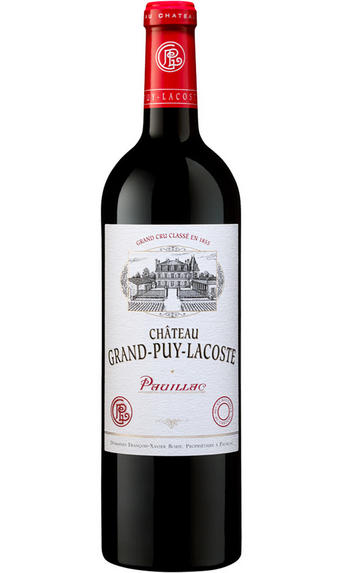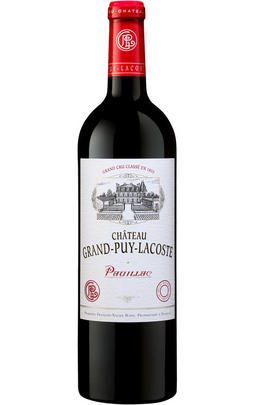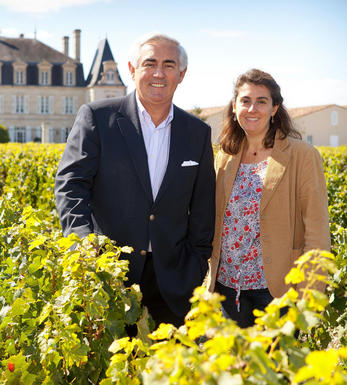
2022 Château Grand-Puy-Lacoste, Pauillac, Bordeaux

Critics reviews
The 2022 Grand Puy Lacoste was picked from 7 to 23 September and contains more Merlot due to the high quality of the fruit, matured in 75% new oak. There is 14.2% alcohol. Therefore, this lends this GPL a little more precocity and sensuality than other vintages, not cut from the same "classical" cloth as 2019 or 2020.
Underlying this velvety veneer are enticing traits of freshly-rolled tobacco and undergrowth. The palate is medium-bodied with finely-sculpted tannins. Silky smooth in texture, so much so that it belies that backbone underneath.
A peacock's tail of mineral-rich, quite peppery black fruit is on the finish, completing a Pauillac endowed with huge potential.
Drink 2030 - 2065
Neal Martin, Vinous.com (May 2023)
The 2022 Grand-Puy-Lacoste is a very pretty wine. Forward and quite showy, the 2022 comes across as a wine that will drink well with minimal cellaring. Succulent dark cherry, plum, leather, incense and dried herbs are nicely delineated.
There’s good complexity and depth, but the radiance of the year is front and centre. Hints of blood orange, pomegranate, spice and a pretty rose petal/violet note linger.
Drink 2030 - 2052
Antonio Galloni, Vinous.com (May 2023)
Inky depths to the colour. Violet edging, bitter black chocolate and graphite can feel the grain of the tannins and the beautiful balance and juice to damson, cassis and plum puree fruits.
Capturing just the right amount of drama without sacrificing Pauillac character, this wine will age exceptionally well, with a depth of flavour and a rich tannic frame showing how 2022 can succeed in the right hands.
75% new oak, 3.57ph. Harvest earliest ever, beginning on September 7 (2003 was September 15), 60% of production in the 1st wine, Eric Boissenot consultant. 38hl/h yield, a little over the Pauillac average.
Drink 2032 - 2048
Jane Anson, JaneAnson.com (May 2023)
A blend of 79% Cabernet Sauvignon and 21% Merlot, the 2022 Grand-Puy-Lacoste is a brilliant classic in the making, wafting from the glass with aromas of dark berries, violets and pencil shavings, followed by a medium to a full-bodied, layered and concentrated palate that exhibits beautiful structural refinement and purity of fruit.
Classy and integrated, it is reminiscent of a modern-day and less forbiddingly structured version of this estate's brilliant 1982. A blend of 79% Cabernet Sauvignon and 21% Merlot, the 2022 Grand-Puy-Lacoste is a brilliant classic in the making, wafting from the glass with aromas of dark berries, violets and pencil shavings, followed by a medium to a full-bodied, layered and concentrated palate that exhibits beautiful structural refinement and purity of fruit.
Classy and integrated, it is reminiscent of a modern-day and less forbiddingly structured version of this estate's brilliant 1982.
William Kelley, Wine Advocate (April 2023)
79% Cabernet Sauvignon, 21% Merlot. Cask sample.
Deep colour. Marked Cabernet nose. Cassis with a vibrant freshness. Juicy fruit and well-integrated tannins with a more textural feel this year. Reserved, measured, and structured. Identity unchanged.
Drink 2032 - 2050
James Lawther MW, JancisRobinson.com (May 2023)
A very structured and rich red with blackberry and chocolate. Full-bodied with a solid core of fine tannins and a fresh and muscular finish. Dusty texture. Yet it remains bright and vivid. 3.55 pH. 79% cabernet sauvignon, 21% merlot.
James Suckling, JamesSuckling.com (April 2023)
Gorgeous vibrant purple colour in the glass, deep and darkly scented, black bramble fruits, flowers, cinnamon, dark chocolate and liquorice. Firm and forward, this is generous but sleek, so you get power, concentration, juicy liveliness, and great tension and energy. I really do like the ease of this; it's not trying too hard but delivered with poise, punch and purity.
An excellent wine that really over-delivers - so well presented, detailed, finessed and refined but still with the strength coming at the end in the wave of liquorice, dark chocolate and wet stone terroir markers. A brilliant wine with the potential to deliver such excellent drinking pleasure. I love it.
3.57pH. A yield of 38hl/ha. 60% grand vin, 40% second wine. Eric Boissenot consultant. Harvest 7-23 September. Yield of 38hl/ha. Ageing in French oak, 75% new.
Drink 2027 - 2050
Georgina Hindle, Decanter.com (April 2023)
About this WINE

Chateau Grand-Puy-Lacoste
Château Grand-Puy-Lacoste is a 5ème Cru Classé Pauillac estate which has for many years been consistently outperforming its classification. Grand-Puy-Lacoste is located a couple of kilometres west of the town of Pauillac and is owned and run by François-Xavier Borie.
Grand-Puy-Lacoste's 90 hectares of vines (Cabernet Sauvignon 75%, Merlot 25%) are in one block surrounding the substantial 19th century château and lie on deep gravel beds over limestone. The grapes are fermented in temperature-controlled stainless steel vats and the wine is then matured in oak barriques (50% new) for 18 months.
Grand-Puy-Lacoste combines marvellous cigar box perfume with rich blackcurrant and cassis fruit and velvety power which is the epitome of top class Pauillac at its very best.

Pauillac
Pauillac is the aristocrat of the Médoc boasting boasting 75 percent of the region’s First Growths and with Grand Cru Classés representing 84 percent of Pauillac's production.
For a small town, surrounded by so many familiar and regal names, Pauillac imparts a slightly seedy impression. There are no grand hotels or restaurants – with the honourable exception of the establishments owned by Jean-Michel Cazes – rather a small port and yacht harbour, and a dominant petrochemical plant.
Yet outside the town, , there is arguably the greatest concentration of fabulous vineyards throughout all Bordeaux, including three of the five First Growths. Bordering St Estèphe to the north and St Julien to the south, Pauillac has fine, deep gravel soils with important iron and marl deposits, and a subtle, softly-rolling landscape, cut by a series of small streams running into the Gironde. The vineyards are located on two gravel-rich plateaux, one to the northwest of the town of Pauillac and the other to the south, with the vines reaching a greater depth than anywhere else in the Médoc.
Pauillac's first growths each have their own unique characteristics; Lafite Rothschild, tucked in the northern part of Pauillac on the St Estèphe border, produces Pauillac's most aromatically complex and subtly-flavoured wine. Mouton Rothschild's vineyards lie on a well-drained gravel ridge and - with its high percentage of Cabernet Sauvignon - can produce (in its best years) Pauillac's most decadently rich, fleshy and exotic wine.
Latour, arguably Bordeaux's most consistent First Growth, is located in southern Pauillac next to St Julien. Its soil is gravel-rich with superb drainage, and Latour's vines penetrate as far as five metres into the soil. It produces perhaps the most long-lived wines of the Médoc.
Recommended Châteaux
Ch. Lafite-Rothschild, Ch. Latour, Ch. Mouton-Rothschild, Ch. Pichon-Longueville Baron, Ch. Pichon Longueville Comtesse de Lalande, Ch. Lynch-Bages, Ch. Grand-Puy-Lacoste, Ch, Pontet-Canet, Les Forts de Latour, Ch. Haut-Batailley, Ch. Batailley, Ch. Haut-Bages Libéral.

Cabernet Sauvignon Blend
Cabernet Sauvignon lends itself particularly well in blends with Merlot. This is actually the archetypal Bordeaux blend, though in different proportions in the sub-regions and sometimes topped up with Cabernet Franc, Malbec, and Petit Verdot.
In the Médoc and Graves the percentage of Cabernet Sauvignon in the blend can range from 95% (Mouton-Rothschild) to as low as 40%. It is particularly suited to the dry, warm, free- draining, gravel-rich soils and is responsible for the redolent cassis characteristics as well as the depth of colour, tannic structure and pronounced acidity of Médoc wines. However 100% Cabernet Sauvignon wines can be slightly hollow-tasting in the middle palate and Merlot with its generous, fleshy fruit flavours acts as a perfect foil by filling in this cavity.
In St-Emilion and Pomerol, the blends are Merlot dominated as Cabernet Sauvignon can struggle to ripen there - when it is included, it adds structure and body to the wine. Sassicaia is the most famous Bordeaux blend in Italy and has spawned many imitations, whereby the blend is now firmly established in the New World and particularly in California and Australia.


Buying options
Add to wishlist
Description
Blend: 79% Cabernet Sauvignon; 21% Merlot.
Part of Grand-Puy-Lacoste’s appeal is that its tannins always seem to have the polished walnut grain of a much-loved piece of furniture. This is to the fore this year, shepherding the abundant, expressive fruit across the palate. The colour is astonishingly deep for a wine that has some delicacy.
The bouquet has dark cherry and cedar notes, following through to the palate to be joined by lead pencil shavings and violets. A raised eyebrow of dusty tannin knots everything together. This is a lovely expression of why we love “GPL”: an understated aristocrat having a bit of fun.
Drink 2029 - 2050
Score: 16.5/20
Mark Pardoe MW, Wine Director, Berry Bros. & Rudd (May 2023)
wine at a glance
Delivery and quality guarantee